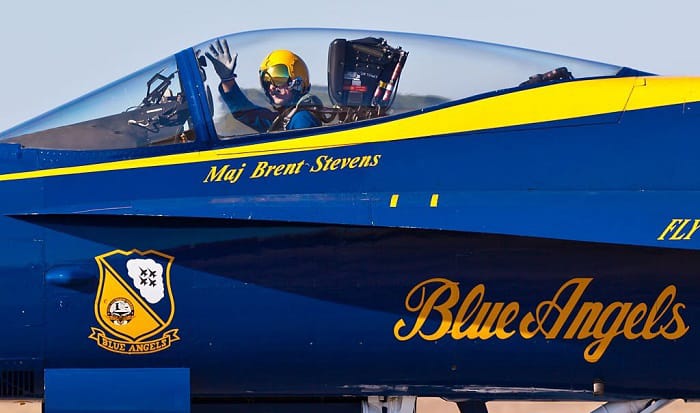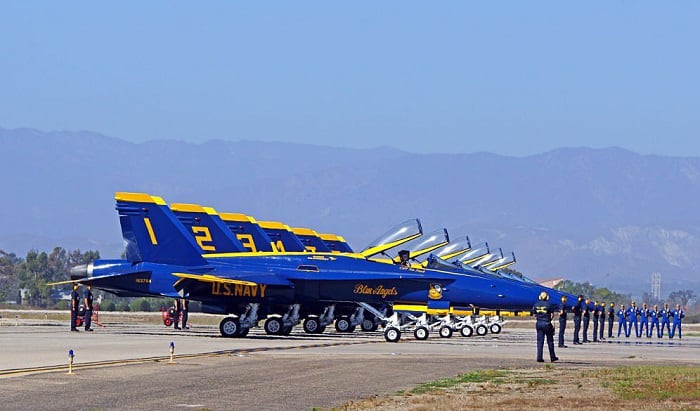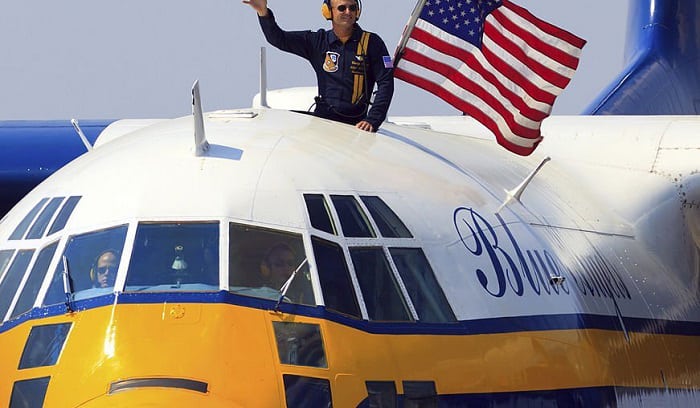If you have read about “Who are the Blue Angels pilots?” and have developed an interest, you will be eager to learn how to become a Blue Angels pilot. In this article, we will outline the requirements and steps for you and answer relevant frequently asked questions. So, you can confidently venture into the path of becoming a Blue Angels pilot. Read on!
Table of Contents
Steps to Becoming a Blue Angels Pilot
Step 1. Make sure you meet the minimum Blue Angels requirements
In order to be a Blue Angels applicant, you must be an active-duty Navy or Marine Corps pilot. You must also be carrier-qualified with at least 1,250 tactical jet flight hours or 1,2000 flight hours as a commander and career-oriented.
- Note: Logging 1,250 tactical jet flight hours is about the same as eight years of flying Navy jets.
Step 2. Put together your application package
You will need to:
- Get a “Request for Consideration” letter
- Get a “Commanding Officer’s Endorsement” document
This is essentially your Commanding Officer agreeing, in writing, to let you apply to join the Blue Angels and to detach you early if you are selected.
- Fill out the “CNATRA Form 1331/1”
Print it out, then fill it out completely. To get an idea of what you will need to fill out (before downloading the form), continue reading.
On the first page, you will be asked to provide basic information, such as your:
-
- Name
- Rank
- Date of Rank
- SSN or Designator Number
- Date of Birth
- Commission Source
- Enlistment History (Meaning, whether you were previously enlisted)
- Number of Years & MOS
- Highest Rate
- Present Home & Permanent Home Address
- Name of University or College Attended (Plus the years and degree information)
- Present Duty Station
- Present Assignment
- Future Deployment Dates
- Shore Duty Rotation Dates
- Phone Number
- Marital Status
If you are married, you will need to specify:
-
- How long you have been married
- Your spouse’s name
- Whether you have children
Afterward, there will be a section asking for more details on:
-
- Your previous duty stations
Starting from the last station, for each, you will have to indicate:
-
- The station or squadron
- The billet
- The dates
- The names of the commanding officers
- The units (Including the combat experience and dates)
- The awards and decorations
- Any convictions (Civilian, UCMJ, or NJP)
- Your jet flying records
The names of the jets (by model) and the total hours logged
The names of the props (by model) and the total hours logged
The number of carrier landings (for both day and night) and the INST. rating
On the second page, you will need to list at least five officers as references. You can also list any previous Blue Angels that can be contacted for a recommendation. The details necessary are:
-
- Your reference’s name
- Your reference’s present duty address
- Your reference’s service location
Finally, you will need to provide two long answers. The two questions are:
-
- What attributes would you bring to the Navy Flight Demonstration Squadron?
- Why do you desire to become a member of the squadron?
To wrap up, you will also need to read and acknowledge the Privacy Act Statement (as pictured in the line below) with your signature and the date.
- Provide an official full-length photo
You can take a photo at any base photoshop or photography studio. But please note that you must use the OMPF’s digital officer photo upload form. In addition, you need to remove the ‘PH’ before sending in the photograph.
- Provide a list of professional experience and qualifications
- Provide a biography
This must be in the standard Navy biography format, up to 1 page.
- Provide contact information for a medical record review
You need to send an email to the Blue Angels Flight Surgeon (Currently Lt. Monica Borza). Include your full name and DoD ID number.
Step 3. Submit your application package to the Blue Angels team
You can do this by visiting the Applications Officer or emailing the Applicants Officer.
Step 4. Attend air shows
As an applicant, you will need to come to scheduled air shows to see (firsthand) the briefing process and how the Blue Angels execute their missions, as well as interact with the local community. Attending these air shows is also a chance for the team to meet you and get to know you. Most of the time, you will meet other military and civilian members in the air show industry as well. It is recommended that you go to at least 2 to 3 air shows. The dress code is business casual. And do not bring others with you.
Finalists will be selected mid-season and will sit through an interview at the Blue Angels’ squadron. It is in Pensacola, Florida. Ultimately, the pilots will be chosen through a unanimous vote. The only exception is the Flight Leader (also referred to as the Commanding Officer), who is chosen by the Chief of Naval Air Training.
Relevant FAQs
How many Blue Angels pilots have there been?
There have been more than 260 past Blue Angels pilots and over 37 Flight Leaders (also known as the Boss or Commanding Officer).
Who are the current Blue Angels pilots?
Every year, 3 tactical jet pilots, 2 support officers, and 1 Marine Corps pilot join the Blue Angels team. You can find the names and pictures of Blue Angels pilots on their official website. Click here.
Are there female Blue Angels pilots?
Yes, there are. The first female Blue Angel pilot was Maj. Katie Higgins Cook. Here is a video of her flying in San Diego.
As said above, to become a Blue Angel, you must either be an active-duty Navy or Marine Corps pilot. So, the Blue Angels are not ONLY Navy pilots.
How much does a Blue Angels pilot earn?
Just like others in the military, Blue Angels pilots salary is based on their rank and time in service.
You can find details in this PDF chart here. Note, Blue Angels members do not receive extra or bonus pay.
How long do pilots serve in the Blue Angels?’
Blue Angels Officers typically serve for 2 to 3 years and enlisted personnel serve 3 to 4 years. Both Officers and enlisted personnel return to their fleet after their Blue Angels Tour of Duty.
What is the training like for Blue Angels pilots?
Blue Angels pilots have winter training and season training.
The former is at NAF El Centro, California. Each day, pilots fly two practice sessions, and they do this for 6 days a week. They need to fly at least 120 training missions in total.
The latter is at their home base in Pensacola, Florida. Usually, the practice is on Tuesday and Wednesday’s mornings. On Thursday, they have orientation maneuvers practice, and on Friday, they do a rehearsal.
Shows happen on Saturdays and Sundays. They have Monday off and Sunday is reserved for maintenance and related work.
Conclusion
Now, you know the requirements and steps to becoming a Blue Angels pilot. Feel free to bookmark this article on, “How to become a Blue Angels pilot?” for future reference. If what you have read was helpful and interesting, please leave us a comment. Help us share this with other readers seeking information on the matter, as well. Thank you!
Read more: Branch of the US military that features the blue angels.

I am Everett Bledsoe, taking on the responsibility of content producer for The Soldiers Project. My purpose in this project is to give honest reviews on the gear utilized and tested over time. Of course, you cannot go wrong when checking out our package of information and guide, too, as they come from reliable sources and years of experience.




